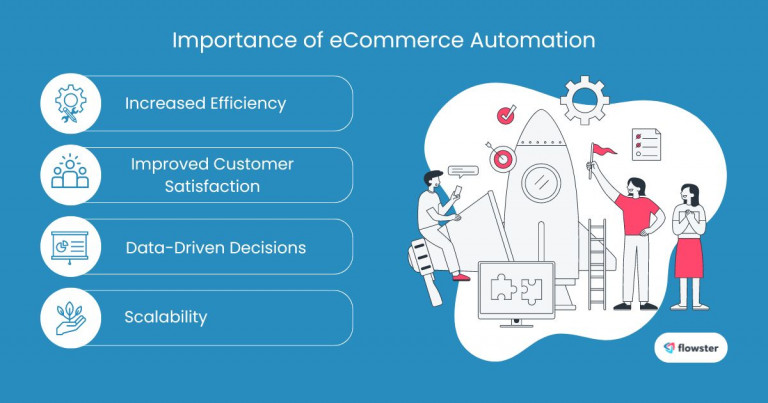In today’s competitive eCommerce landscape, businesses are facing unprecedented challenges. Rising customer expectations, increasing competition, and the need for rapid scaling have put immense pressure on online retailers. To stay ahead of the curve and thrive in this fast-paced environment, it is imperative to embrace innovative solutions that can streamline operations and boost efficiency. One such solution is eCommerce automation. This blog post will delve into the concept of eCommerce automation, explore its significance, and provide practical guidance on how to effectively implement it in your business.
Article Outline
What is eCommerce Automation?
eCommerce automation refers to the use of technology to automate repetitive tasks and processes within an online retail business. By leveraging software and tools, businesses can streamline operations, reduce manual errors, and improve overall efficiency.
Common examples of eCommerce automation include:
- Inventory management: Automated systems can track stock levels, manage product information, and optimize inventory replenishment to prevent stockouts and overstocking.
- Order fulfillment: Automation can streamline the order fulfillment process, from order processing and packing to shipping and delivery.
- Customer service: Chatbots, automated email responses, and self-service portals can provide efficient customer support and improve response times.
- Marketing automation: Tools can help automate email campaigns, social media scheduling, and personalized marketing efforts to reach the right customers with the right message.
The Importance of eCommerce Automation
eCommerce automation offers numerous benefits that can significantly impact the success of online businesses.
Increased Efficiency:
- Streamlined operations: Automation can eliminate repetitive tasks, reduce manual errors, and free up employees to focus on more strategic activities.
- Time savings: By automating routine processes, businesses can save valuable time and resources.
- Improved productivity: Automated systems can enhance overall productivity and efficiency within the organization.
Improved Customer Satisfaction:
- Faster response times: Automated customer service tools can provide instant responses to customer inquiries, improving satisfaction levels.
- Personalized service: Automation enables businesses to deliver personalized experiences to customers, fostering loyalty and repeat business.
- Enhanced customer support: Automated systems can provide 24/7 support, ensuring customers always have access to assistance.
Enhanced Data-Driven Decision Making:
- Valuable data insights: eCommerce automation generates vast amounts of data that can be analyzed to identify trends, optimize performance, and make informed business decisions.
- Data-driven strategies: By leveraging data-driven insights, businesses can develop more effective marketing campaigns, improve product offerings, and enhance customer experiences.
Scalability:
- Efficient scaling: Automation enables businesses to scale operations efficiently as they grow, without compromising quality or customer service.
- Flexibility: Automated systems can adapt to changing business needs, ensuring continued growth and success.
By embracing eCommerce automation, businesses can unlock its potential to drive efficiency, improve customer satisfaction, make data-driven decisions, and achieve sustainable growth.
When sales and operations share one workflow, trusted CPQ implementation partners can align product rules, pricing logic, and approvals so quotes stay accurate. This reduces back-and-forth and keeps customers informed from the first quote through delivery.

Examples of eCommerce Automation
eCommerce automation encompasses a wide range of applications that can benefit businesses of all sizes. Here are some common examples of how automation can be implemented:
Inventory Management:
- Optimized stock levels: Automated inventory management systems can help businesses maintain optimal stock levels, preventing stockouts and overstocking.
- Product performance tracking: By tracking product sales and inventory data, businesses can gain insights into product popularity and adjust their inventory accordingly.
- Reduced manual errors: Automated systems can help eliminate manual errors in inventory management, such as inaccurate stock counts or incorrect order fulfillment.
Order Fulfillment:
- Streamlined order processing: Automation can speed up the order processing workflow, from order receipt to fulfillment.
- Efficient packing and shipping: Automated packing stations and shipping labels can reduce manual handling and improve shipping accuracy.
- Reduced shipping costs: By optimizing packing and shipping processes, businesses can potentially reduce shipping costs.
Customer Service:
- Chatbots and automated responses: Chatbots can handle common customer inquiries and provide instant responses, freeing up human agents to handle more complex issues.
- Improved response times: Automated email responses can be triggered based on specific customer actions, ensuring timely communication and improved customer satisfaction.
- Self-service options: Automated self-service portals can empower customers to find answers to their questions and resolve issues independently.
Marketing Automation:
- Automated email campaigns: Email marketing automation tools can help businesses create and send targeted email campaigns based on customer behavior and preferences.
- Social media scheduling: Automated social media scheduling tools can help businesses maintain a consistent presence on social media platforms without requiring constant manual updates.
- Personalized marketing: Automation can enable businesses to deliver personalized marketing messages to individual customers, increasing the likelihood of conversions.
These are just a few examples of how eCommerce automation can be applied to various aspects of an online business. By exploring these use cases and identifying areas where automation can add value, businesses can unlock its potential to improve efficiency, enhance customer experience, and drive growth.
Flowster's AI-Driven Automation
How to Automate eCommerce Workflows Effectively
Implementing eCommerce automation requires a strategic approach to ensure maximum benefits. Here are some key steps to consider:
Identify Repetitive Tasks:
- Prioritize automation: Begin by identifying tasks that are repetitive, time-consuming, or error-prone. These are prime candidates for automation.
- Analyze workflows: Examine your existing workflows to pinpoint areas where automation can streamline processes and improve efficiency.
Choose the Right Tools:
- Evaluate options: Research and compare different automation tools based on your specific needs, budget, and the complexity of your workflows.
- Consider scalability: Select tools that can grow with your business and accommodate future expansion.
- Evaluate integrations: Ensure that the chosen tools can integrate seamlessly with your existing eCommerce platform and software.
Integrate with Existing Systems:
- Ensure compatibility: Verify that the automation tools you select are compatible with your current systems and infrastructure.
- Minimize disruptions: Plan for a smooth integration process to minimize disruptions to your operations.
- Utilize APIs: Leverage APIs to connect automation tools with your existing systems and enable data exchange.
Test and Optimize:
- Thorough testing: Implement a thorough testing phase to ensure that automation processes are functioning as expected and delivering the desired results.
- Monitor performance: Continuously monitor the performance of your automated workflows to identify areas for improvement.
- Make adjustments: Be prepared to make adjustments and optimizations as needed to refine your automation processes.
Consider Security:
- Protect sensitive data: Implement robust security measures to protect sensitive customer and business data during automation.
- Regular updates: Keep your automation tools and software up-to-date with the latest security patches and updates.
- Monitor for threats: Regularly monitor your systems for potential security threats and take appropriate action if necessary.
By following these guidelines, you can effectively automate your eCommerce workflows and reap the benefits of increased efficiency, improved customer satisfaction, and enhanced business growth.
Capture Your Processes in Minutes!
Conclusion: The Power of eCommerce Automation
eCommerce automation offers a powerful solution for businesses seeking to improve efficiency, enhance customer satisfaction, and drive growth. By automating repetitive tasks and processes, businesses can streamline operations, reduce errors, and free up valuable resources.
Key benefits of eCommerce automation include:
- Increased efficiency
- Improved customer satisfaction
- Enhanced data-driven decision making
- Scalability
To effectively implement eCommerce automation, it is essential to identify suitable tasks for automation, select the right tools, integrate with existing systems, test and optimize processes, and prioritize security.
By leveraging eCommerce automation, businesses can:
- Streamline operations
- Reduce costs
- Improve customer experience
- Gain a competitive edge
Ready to start automating your eCommerce workflows? Explore the wide range of free eCommerce workflow templates available on the Flowster Marketplace. These templates can provide a solid foundation for your automation initiatives.
Additionally, Flowster offers “Done-for-You” services to assist businesses in implementing automation solutions without the need for extensive technical expertise.
Don’t miss out on the opportunity to transform your eCommerce business through automation. Take the first step today and start exploring the possibilities that eCommerce automation can offer.




